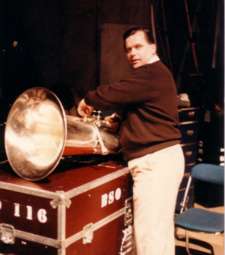Some more here for you wind instrument players. Continuing on the subject of Getting Air. I have discovered THREE WAYS of getting the air into the lungs, so that it can be blown forth through your instrument. 1. “normal” breathing 2. “sniffing” between notes while playing 3. cyclical, or, circular breathing.
1. “Normal” Breathing Please read recent FB article entitled AIR — GETTING IT — 1. This is the usual method of obtaining air. You will breathe this way, because it is automatic. Now, let’s go to
2. Sniffing Between Notes Bill Bell used to talk about ‘sniffing.’ I am sure that he employed this technique in his playing. He knew these things. He was good. ( also he was from Iowa — my home state — now there is some real air to sniff! ) In my experience, I have found it to be invaluable, primarily used while playing moderately moving, or even rapidly moving eighth notes. Rather than leaving a note out, here and there, ALL the notes can be played. Also this technique can be used to minimize the length of space between moderate-length notes, e.g., a series of quarter notes, or half notes. For example, when the conductor requests “no space between notes on the tuba soli in the Dies Irae, in Berlioz’ Symphonie Fantastique, those tuba players who are not able to employ cyclical, or circular breathing, can still produce the requested effect with a partial-filling between each note — accomplished by a quick sniff, then repeated after the next note, and so forth. One is never completely filled, yet always has enough air to play each note, which another rapid sniff following each note. Each note is sustained ‘full-length’ and has a small space, to avoid making one large space after four or so notes are played. In a good hall, with some helpful reverberation, the effect presented to the listener “our there,” is no space at all between notes. Only the tuba player knows…..
How is sniffing accomplished? In this way: 1. the mouthpiece is not removed from the embouchure, nor is the “playing” position or playing pressure reduced, while taking the breath. 2. air is obtained by an action of ‘tummy’ muscles, diaphragm — the pulling in of the air takes place down there, with no movement whatsoever above that area. The mouthpiece remains IN PLAYING POSITION, with PLAYING PRESSURE, and nothing changes in the embouchure area. There does takes place a very quick ‘sniff’ through the nose, and playing just continues. It is NOSE, not MOUTH. To an observer, there is no change to be seen, except, perhaps, in the tummy region, or a slight dilation of the nostrils. To the listener, it is a ‘wonderment’ as to how the tuba player is doing it….
I have observed that there are very few wind instrument performers who employ this wonderful technique. I suggest that every serious player learn this…….it is simple…….and perfect it. Are you really serious? 🙂
How does one perfect sniffing?…….the same way so much of the learning process succeeds……..do it, get it right, and repeat it. When that is done, then, SPEED IT UP, all the while being certain that you’re still doing it properly. Practically, take an easy note, an “open” pitch, or any other easily produced pitch, begin by playing an eighth note – nose-breathe – eighth note – nose-breathe – etc., then speed it up. You will note that after a while you will feel a pleasant “achy-ness” in the tummy area. This is good news. It means that there are muscles which are finally being made to work, and they are just a bit “tired,” but are beginning to develop. These abdominal muscles, with the diaphragm, will take those “sniffs” more and more easily and quickly. Eventually, you may be able to breathe between 16th notes. It is amazing to what degree of development this method of breathing can attain! Additionally, this breathing technique will eventually almost seem to be “automatic,” used without any thought beforehand.
Once, in the Boston Symphony rehearsing a contemporary piece, we in the back row were required to play moderately moving eighth notes, very loudly, for about 45 seconds. Sort of a musically muscular “jackhammer” effect. The trombonists consulted as to where each of them would breathe so that no notes were left unplayed. I sniffed my way through the tuba part–fortissimo. After playing through this passage at rehearsal a couple of times, bass trombonist Doug Yeo asked me, “How do you play that without leaving out any notes?” So I told him, and with his customary innate alacrity he grabbed this, and it has been a part of his playing and teaching since, I believe…notably in the bass trombone solo in Haydn’s The Creation.
And there might be some of you who will get curious and begin experimenting with it, as well. It is easy.
There is much to be said about the third method of GETTING AIR, cyclical/curcular breathing — too much to include in this short article. But it is GOOD! It will not only be added to “normal breathing,” but will be presented as a partner, working in conjunction with “normal breathing.” Stay tuned. I pray that God will bless the music-making of those of you who ask Him. If you don’t know God, it is possible…….in fact, so, so, so easy. His Name is JESUS. Call out to Him.
